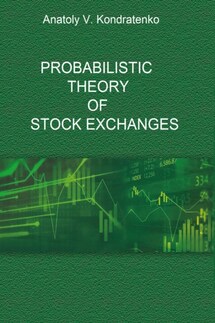Probabilistic Theory of Stock Exchanges - страница 10
The main paradigm of probabilistic economics for us is the following statement already formulated above. All markets consist of people – buyers of some goods and simultaneously sellers of these goods. Everything the market does is done by these people, and it is the actions of all these people in the market that determine all the market results [Mises, 2005]. A similar claim was once made by Richard Feynman et al. [1978] regarding physical multiatomic systems. It is this circumstance that allows us to establish an analogy between multi-agent market economic systems and multiatom physical systems and to bring physical approaches and language into economic theory. Based on this main paradigm and with careful consideration of all the basic features of human activity, explored in detail by Mises [2005], we will define the following six principles of probabilistic economics, which are essentially general postulates:
Principe 1. Supply and demand principle;
Principe 2. Agent principle;
Principe 3. Institutional and environmental principle;
Principe 4. Dynamic and evolutionary principle;
Principe 5. Trade volume maximization principle;
Principe 6. Uncertainty and probability principle.
The demand and supply principle reflects the fact that almost all important effects and processes in the market are determined by the interaction of supply and demand in the market. The agent principle testifies to the unique driving role of interacting market agents and the significant contribution to this interaction of social cooperation between them in the modern market economy. The institutional and environmental principle expresses the fact that the interaction of agents with different social institutions, different stakeholders and the external natural environment should be taken into account together with the interaction between the agents. The dynamic and evolutionary principle reflects the fact that market behavior is to some extent deterministic in nature and therefore, generally, can be analyzed by means of some equations of motion that describe both stationary behavior and the evolution of markets. The trade volume maximization principle determines the direction of the generally fairly free market under the influence of market forces. The uncertainty and probability principle shows that all market processes and phenomena, including decision-making, are probabilistic in nature and thus help us to understand what mathematical apparatus we need to adequately describe the behavior of agents and the market as a whole in the circumstances of uncertainty.
In essence, these principles define the main acting forces in the market and the main features of the market structure, so when performing specific studies of markets in our physico-economic models, they should all be taken into account, if possible, simultaneously, since they all represent market effects of the same significance in terms of influence on the final result of market operation, namely on the price structure and trade volumes in the market at each moment. If, for example, a certain economic study does not take into account the influence of the state, it cannot claim to be an adequate description of the modern economic world in which the role of the state is paramount: the state can both accelerate and suppress economic activity of other market agents. And the role of the state in the modern economy is twofold: it can both set important rules and introduce new institutions, thereby influencing the strategies of market agents, and be an active and strong market agent itself.







